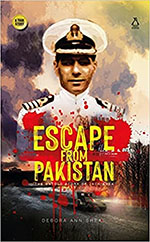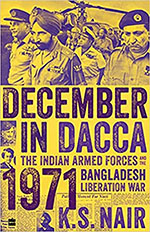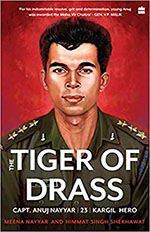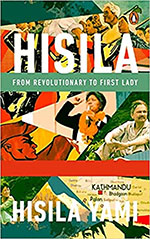My presentation at the FSI on UN Peacekeeping
writings of ali ahmed, with thanks to publications where these have appeared. Download books/papers from dropbox links provided. Also at https://independent.academia.edu/aliahmed281. https://aliahd66.substack.com; www.subcontinentalmusings.blogspot.in. Author India's Doctrine Puzzle: Limiting War in South Asia (Routledge 2014). Ashokan strategic perspective proponent. All views are personal. @aliahd66
My other blog: Subcontinental Musings
Wednesday 21 December 2022
Tuesday 20 December 2022
Sunday 18 December 2022
https://www.thebookreviewindia.org/books-in-brief-11/
There is much in common between these six books. They all carry a subtitle, are inexpensive and light reading, though about a rather heavy topic; are tales simply told; and are about the lesser remarked aspects of war. Other than the one by Hisila, they have been penned by people other than the respective protagonists, with Punia having his daughter along as co-author. All are of stories in southern Asia, other than Punia’s which is situated in West Africa.
However, the most significant factor that compels clubbing them together here is that they are stories of high, pulsating adventure. Consequently, they are recommended reading for youth, who in times of internet have lost the yen for reading. The six can leave behind a constructive hobby for in their coverage of war time settings of the adventures they narrate, they help educate. The adventures themselves serve to inspire, since all the central characters are memorable, having distinguishing character traits that not only mark them out but also help them cope with the adventures that befall each.
 Reviewing them chronologically here, we begin with Mistry’s portrayal of the adventures of his uncle by marriage, Dr. Jehangir Anklesaria. The good doctor was posted as port medical officer in Rangoon when the Japanese struck at Pearl Harbour. The Japanese—‘runts’ in the racist prototype held before they overran South East Asia—were at Rangoon’s doors within six months. The British empire’s outpost there scrambled to get out of the way along with the retreating armies of the empire over which the sun never set. The book follows Jehangir as his familiar world crashes about him and his family. He hastily dispatches his family to Kolkata and readies to help 50,000 refugees, mostly Indian, making their way via the land route back to India. Jehangir’s challenge was to prevent cholera outbreak at a major transit point, lest it spread to the 30,000 British, Indian, Chinese and Burmese troops and sap morale. The book follows him from Rangoon, across the Irrawaddy and the Chindwin, through the refugee transit camp at Monywa and, finally, in the last leg of the arduous journey through the malarial 24th Mile. Just when you thought it couldn’t get worse, the monsoon hits the serrated edges of the Arakan Yoma ranges as the good doctor struggles alone over the leech-infested and snake-lined pass between Tamu on the Burma border and Palel in Manipur: a 24 Mile eternity-long gap. The author rightly brings out that we owe our second language English to the likes of Dr. Anklesaria, else it could well have been Japanese.
Reviewing them chronologically here, we begin with Mistry’s portrayal of the adventures of his uncle by marriage, Dr. Jehangir Anklesaria. The good doctor was posted as port medical officer in Rangoon when the Japanese struck at Pearl Harbour. The Japanese—‘runts’ in the racist prototype held before they overran South East Asia—were at Rangoon’s doors within six months. The British empire’s outpost there scrambled to get out of the way along with the retreating armies of the empire over which the sun never set. The book follows Jehangir as his familiar world crashes about him and his family. He hastily dispatches his family to Kolkata and readies to help 50,000 refugees, mostly Indian, making their way via the land route back to India. Jehangir’s challenge was to prevent cholera outbreak at a major transit point, lest it spread to the 30,000 British, Indian, Chinese and Burmese troops and sap morale. The book follows him from Rangoon, across the Irrawaddy and the Chindwin, through the refugee transit camp at Monywa and, finally, in the last leg of the arduous journey through the malarial 24th Mile. Just when you thought it couldn’t get worse, the monsoon hits the serrated edges of the Arakan Yoma ranges as the good doctor struggles alone over the leech-infested and snake-lined pass between Tamu on the Burma border and Palel in Manipur: a 24 Mile eternity-long gap. The author rightly brings out that we owe our second language English to the likes of Dr. Anklesaria, else it could well have been Japanese.
The second book finds us in the independent era with India in the midst of yet another war, its second with Pakistan. The 1965 War finds the family of Jack Shea in Karachi, then capital of Pakistan. Jack is the naval attaché at the High Commission. The author—daughter of Jack Shea—writes of the carefree days before the war, with fishing in the Arabian Sea as Jack’s way not merely to spend time, but to keep an eye on the maritime happenings around Karachi port. The book reveals how Jack was central to the ‘escape from Pakistan’ of an undercover police officer. The agent had spied on Pakistan, resulting in—among other factors—Pakistan losing the war. Since Pakistan’s army wanted revenge for being tripped up, they were narrowing down on the agent. Jack stepped up his plan to send him back to India. The cloak-and-dagger stuff and the adventure of the police officer as he trudges on camel back through the southern Sindh desert to the India border makes for fascinating reading. Clearly, his cool head and valiantly facing up to the undiplomatic consequence were rightly rewarded with a distinguished service medal, a rare award at his rank.
 The third book is about India’s next war, the 1971 War. The book, released to coincide with the year-long observation of the fiftieth anniversary of the war, appears intended to transmit tales of derring-do in the war to the next generation. This book is different from the others in that it is not about one individual’s adventure, as much a collage of a set of individuals. Nair is a self-confessed war aficionado, who puts his school-boy enthusiasm to good use in communicating the exploits of soldiers, airmen and sailors to the younger generation that has not seen war. Nair intends the book to recapture the empathy with which India intervened in East Pakistan. His penchant for details, particularly of air battles and technology, however, leave him word space only for making his point, more as an assertion than as a refutation of the argument that India had other motives, principally strategic, that prompted its intervention. Whereas India did end genocide as Nair records, Nair neglects the possibility that India’s interference partially precipitated the genocide in the first place. Since he believes India’s altruistic reason, he is severe on the United States for being double-faced. The book is a good start point for young enthusiasts to explore not only this war, but also move on to India’s military history–that is increasingly in nationalism-charged times coming in for much revision.
The third book is about India’s next war, the 1971 War. The book, released to coincide with the year-long observation of the fiftieth anniversary of the war, appears intended to transmit tales of derring-do in the war to the next generation. This book is different from the others in that it is not about one individual’s adventure, as much a collage of a set of individuals. Nair is a self-confessed war aficionado, who puts his school-boy enthusiasm to good use in communicating the exploits of soldiers, airmen and sailors to the younger generation that has not seen war. Nair intends the book to recapture the empathy with which India intervened in East Pakistan. His penchant for details, particularly of air battles and technology, however, leave him word space only for making his point, more as an assertion than as a refutation of the argument that India had other motives, principally strategic, that prompted its intervention. Whereas India did end genocide as Nair records, Nair neglects the possibility that India’s interference partially precipitated the genocide in the first place. Since he believes India’s altruistic reason, he is severe on the United States for being double-faced. The book is a good start point for young enthusiasts to explore not only this war, but also move on to India’s military history–that is increasingly in nationalism-charged times coming in for much revision.
 The fourth book is about an interesting, if not controversial episode, in India’s UN peacekeeping experience. Punia was the senior company commander of two subunits–his infantry company and one mechanized one–deployed in a remote corner of an anarchic country, Sierra Leone. The book follows Punia inducting into the country and deploying at the location. How he uses the Indian Army’s well known tools of counter insurgency to ‘Win Hearts And Minds’, WHAM, is well described. Lucky for him, the period was in the era of peacekeeping amateurism; else if done today, he’d have an inquiry sitting on how he distributed UN provisioned food for WHAM. But what is most striking in the book is the self-confession of sorts by him of what could be possible violations of international humanitarian law or war crimes. The Indian contingent was entrapped in a hostage situation by the rebels. The author reveals how he arrived at a plan to shoot his way out of a hostage situation. Its implementation in Operation Khukri arguably amounts to war crimes. While shooting their way out of their encirclement, they leveled the village they were located in, killing civilians in the process. From the narration, it is uncertain if civilians were collateral damage. From this narration though, it is clear that instead of a highpoint in Indian peacekeeping success, the book only succeeds in bringing the operation under a cloud.
The fourth book is about an interesting, if not controversial episode, in India’s UN peacekeeping experience. Punia was the senior company commander of two subunits–his infantry company and one mechanized one–deployed in a remote corner of an anarchic country, Sierra Leone. The book follows Punia inducting into the country and deploying at the location. How he uses the Indian Army’s well known tools of counter insurgency to ‘Win Hearts And Minds’, WHAM, is well described. Lucky for him, the period was in the era of peacekeeping amateurism; else if done today, he’d have an inquiry sitting on how he distributed UN provisioned food for WHAM. But what is most striking in the book is the self-confession of sorts by him of what could be possible violations of international humanitarian law or war crimes. The Indian contingent was entrapped in a hostage situation by the rebels. The author reveals how he arrived at a plan to shoot his way out of a hostage situation. Its implementation in Operation Khukri arguably amounts to war crimes. While shooting their way out of their encirclement, they leveled the village they were located in, killing civilians in the process. From the narration, it is uncertain if civilians were collateral damage. From this narration though, it is clear that instead of a highpoint in Indian peacekeeping success, the book only succeeds in bringing the operation under a cloud.
The fifth book is of a war hero, Captain Anuj Nayyar, authored by his mother and assisted by a well-meaning member of civil society and a biker group that went around the country felicitating families of departed war heroes. The war heroes from the Kargil War have acquired a national profile already, some have had films made on them or figured in films on the war. The book fills out the spirited youth Anuj, showing what goes into the making of heroism. Take his stewardship of the boxing team at the academy. Though not a known boxer himself, since there were no takers for the task, he took it up. Anuj was no spit-and-polish soldier either, who smoked and kept a motorcycle while at the academy. Though not a swashbuckler, he had a girlfriend. On the book cover, showing him with captain’s stars on his shoulder, it is clear he was no budding martinet. The book follows him through the tempering of the steel at the two academies and its being unleashed on an equally redoubtable enemy high on the Kargil ridgeline. Since Anuj’s action is taken as ‘all in a day’s work’ for India’s young officers, it should also prompt the question, what then is the role of the junior leadership in the other ranks. Perhaps, the non-officer leaders build the teams that at the cusp of the moment allow such award winning heroism. The book does well to include 15 pages of mention of such junior leaders, who carried Anuj to immortality on the back of their invisible contribution in wars.
 The last book reviewed here is very different from the others. It is about a war alright, but a civil war in India’s vicinity, Nepal. It’s a memoir of Hisila Yami. That she has retained her name shows that she cannot be reduced to merely being wife of Baburam Bhattarai–revolutionary Prime Minister of Nepal. The book shows her in her various identities as a feminist, revolutionary, architect, mother, wife and politician at various times. Yami’s has been a full life, well compressed in a simply told 300 plus pages. What makes the book interesting is also the description of ten years she spent as a revolutionary in a people’s war. The book captures the innocence of a revolution, with participants ready to die and kill for causes such as equality, federalism, socialism and fraternity. Though Nepal is an intimate neighbour and Nepalis are very evident in our neighbourhoods, there is much we are unaware of about their lives and concerns. The book is a good read, introducing us not only to a very sprightly lady, Hisila, but also to a significant part of our region. Together the books can make younger readers not only take to reading as a hobby but to a life of adventure beyond known confines and comforts.
The last book reviewed here is very different from the others. It is about a war alright, but a civil war in India’s vicinity, Nepal. It’s a memoir of Hisila Yami. That she has retained her name shows that she cannot be reduced to merely being wife of Baburam Bhattarai–revolutionary Prime Minister of Nepal. The book shows her in her various identities as a feminist, revolutionary, architect, mother, wife and politician at various times. Yami’s has been a full life, well compressed in a simply told 300 plus pages. What makes the book interesting is also the description of ten years she spent as a revolutionary in a people’s war. The book captures the innocence of a revolution, with participants ready to die and kill for causes such as equality, federalism, socialism and fraternity. Though Nepal is an intimate neighbour and Nepalis are very evident in our neighbourhoods, there is much we are unaware of about their lives and concerns. The book is a good read, introducing us not only to a very sprightly lady, Hisila, but also to a significant part of our region. Together the books can make younger readers not only take to reading as a hobby but to a life of adventure beyond known confines and comforts.